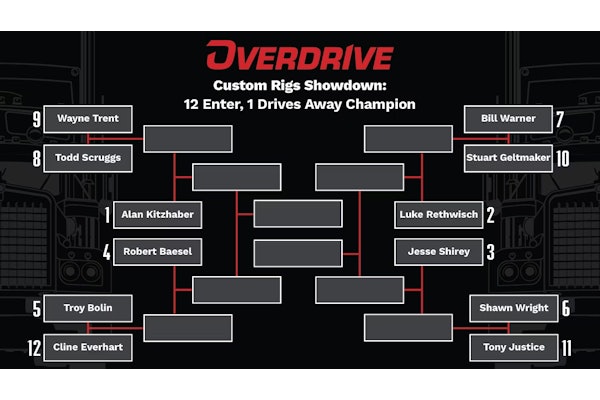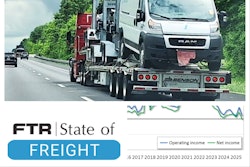Sweetening the deal
Carriers increase incentives for owner-operators
Max Kvidera
As driver pools tighten, carriers are offering sign-on bonuses as high as $10,000 and other incentives to attract owner-operators.
Over the past year, several carriers have increased per-mile and fuel rates, posted bonuses and reduced truck-lease payments to compete for operators or persuade company drivers to convert to ownership.
FFE Transportation has restructured its Drive-to-Own truck lease program by reducing weekly payments and balloon amounts and extending manufacturer warranty programs. In January the carrier launched a driver academy to train applicants looking for a CDL and to educate them on potential career paths. “We want to grow our operators,” says Rob Newell, a vice president at Dallas-based FFE Transportation. “Let’s face it, we’ve lost so many of them in the last three to four years.”
All-owner-operator Roadrunner Transportation Services is offering up to a $10,000 bonus spread over five quarters to experienced operators who sign on to the company’s linehaul division, says Mark Pluff, director of linehaul development. He says the bonus varies depending on lanes where the company wants to add power. He declines to divulge how many operators have signed on, but adds the program has exceeded expectations and will be continued. “We’ve gotten good response from a much higher caliber contractor,” Pluff says.

In August, small all-owner-operator carrier Christenson Transport increased contractor pay from 88 cents a mile to 91 cents and added 5 cents a mile for East Coast routes. The Springfield, Mo.-based carrier offers a $3,500 bonus that is paid by reducing truck lease payments by $75 a week, says Barry McGowen, vice president. “We also pay half the per-mile rate for the first 100 empty miles and increase the percentage as the mileage goes up,” he says.
In February, Barr-Nunn Transportation increased its base rate for owner-operators 3 cents a mile to $1 a mile and 10 cents a mile to 80 cents empty, says Jeff Blank, director of recruiting for the Granger, Iowa-based company. The carrier also offers a Band Pay program that pays on length of haul.
“We’ve probably realized a 15 percent increase in our recruiting this year,” he says. “We’d like to go to 200 owner-operators if we could get them,” up from the current 125.
About 70 percent of the recently added contractors are new to ownership, while the rest were existing owner-operators, Blank says. Earlier in the year, the carrier converted several Barr-Nunn company drivers to ownership. Now the company is attracting more drivers from other carriers who want to become owner-operators.
On June 1, Jacobson Companies of Des Moines, Iowa, increased new operator pay to 95 cents a mile from 93 cents, while also raising existing operator pay by 2 cents a mile. That followed a February increase in the carrier’s sign-on bonus for contractors to $2,500 from $1,000, payable over 90 days, says Joe Santone, vice president of carrier services for the company that works with about 75 contractors.
“All carriers are struggling [to find operators], but over the last 45 days, our recruiting is up about 20 percent,” Santone said. “We’ve changed some of our ads to emphasize the bottom line and the rate increase.”
Among other owner-operator pay developments at carriers:
• Schneider National last March increased van operator pay 5 cents to 95 cents a mile (92 cents a mile plus 3 cents a mile for a quarterly performance premium). The previous November, the Green Bay, Wis.-based company raised tank operator pay 5 cents to $1.05 a mile for all miles.
• At Eagan, Minn.-based Transport America, all owner-operators on July 3 began receiving a 2-cent-a-mile increase to 93 cents for all paid miles. In addition, operators with a hazmat endorsement were paid an additional 2 cents to 95 cents on all paid miles.
• In March, American Central Transport jumped its owner-operator pay to 98 cents for loaded miles and 90 cents for authorized empty miles. The Liberty, Mo.-based company also pays for base plates, permits and bobtail insurance, and offers reimbursement for tolls.
FYI
Walcott holds truckstop jamboree
Nearly 30,000 drivers and their families from 23 states and Canada joined festivities at this year’s Walcott Truckers Jamboree at the Iowa 80 Truck Stop. The event featured more than 175 exhibits, a truck beauty contest, an antique truck display, Trucker Olympics, and a concert by Marty Stuart.
Fleets offer veterans program
Crete Carrier and Shaffer Trucking are now offering a training program for military veterans. The program is available to drivers who have a Class A CDL, have been honorably discharged, have two years of active duty military experience within the past five years and have one year of military tractor-trailer experience.
Ryan claims hillclimb record
Stunt driver Mike Ryan raced his custom-built Freightliner Cascadia to the summit of Mount Washington in Pinkham Notch, N.H., in the Climb to the Clouds hillclimb. He roared up the 7.6-mile serpentine tarmac and gravel road to the 6,288-foot summit in 8 minutes, 2 seconds, claiming a record for the course. He hit a top speed of 94 mph.
New York City law mandates mirrors
A new law will require truck drivers traveling in New York City to mount front-end mirrors. Beginning Jan. 18, 2012, trucks at least 26,000 pounds and base-plated in New York must have the mirrors when traveling through any of the city’s five boroughs.
Caterpillar fined $2.55 million
Caterpillar agreed to pay a $2.55 million penalty as part of a settlement with the U.S. Environmental Protection Agency and the U.S. Department of Justice for alleged Clean Air Act violations. Cat allegedly shipped more than 590,000 highway and nonroad diesel engines without correct emissions controls. Caterpillar also allegedly failed to comply with emission control reporting and engine-labeling requirements.
Used truck orders increase
Used Class 3-8 truck sales in June increased 9 percent over May despite a lack of available inventory, said ACT Research Co. For the year, used sales are 6 percent behind last year’s pace. Meanwhile, the firm reported net trailer orders in June dropped 26 percent from May, the third consecutive monthly decline.
Pilot Flying J opens new center
A newly remodeled plaza center opened in El Paso, Texas, Pilot Flying J Travel Plazas said. The travel stop company was recently named to Nation’s Restaurant News’ 2011 Top 100 list. The plaza is located at 1301 North Horizon Blvd.
TA opens Indiana travel center
TravelCenters of America has opened its newest TA full-service travel center at exit 230 off I-65 in DeMotte, Ind. The location was previously operated as Gas City and was purchased by TA in May.
Navistar sues EPA again over SCR
Jack Roberts
Navistar has filed another suit against the U.S. Environmental Protection Agency. It is the latest round in the ongoing battle between the exhaust gas recirculation-only engine manufacturer and its competitors that use selective catalytic reduction technology to meet 2010 diesel exhaust emissions regulations.
Navistar opted to use in-cylinder EGR technology to meet current standards in conjunction with banked EPA credits for meeting and exceeding pre-existing emissions regulations in effect prior to the 2010 regulations.
Navistar alleges in the suit filed July 5 with the U.S. District Court for the District of Columbia that the truck maker, a contractor it hired and the California Air Resources Board all say nitrogen oxide emissions skyrocket when drivers don’t keep diesel exhaust fluid topped off, rendering EPA’s rule “irrelevant” altogether. Furthermore, Navistar accuses EPA Director Lisa Jackson of not doing her duty to uphold the Clean Air Act and her agency of not doing its part to protect public health.
Navistar Public Relations Manager Stephen Schrier said the lawsuit is about ensuring level competition in the heavy-duty truck market. He notes that testing done by Navistar shows that operators can “defeat” SCR systems by adding water or other substances to the system instead of DEF, allowing trucks to operate indefinitely in violation of 2010 emissions regulations.
EPA recently updated its guidance for certification of truck engines using SCR to reduce emissions, calling on SCR engine makers to continue developing warning systems that alert drivers when the truck’s DEF tank is nearly empty or filled with a liquid other than DEF.
The new guidance, mostly in response to previous claims made by Navistar that SCR technology can be circumvented, also urged OEMs using SCR to research methods that would inhibit tampering with SCR system operation.
Bill would allow heavier trucks on all interstates
Staff Reports
U.S. Senator Olympia J. Snowe, R-Maine, introduced the Commercial Truck Safety Act, legislation intended to ease interstate commerce and enhance safety on highways and secondary roads.
The bill would eliminate what Snowe identifies as inequitable government regulation permitting six-axle trucks weighing up to 100,000 pounds to travel on some states’ interstate highways and not others.
“When it comes to trucks on our interstates, the Department of Transportation has created an inequitable system where some states, including Maine, must seek individual exemptions from year to year while 27 states benefit from permanent exemptions,” said Snowe, a senior member of the Senate Committee on Commerce, Science and Transportation, which has jurisdiction over truck safety.
Presently, trucks weighing more than 80,000 pounds in the remaining 23 states must either unload cargo or travel to their destination on winding secondary roads through small towns.
During a recent pilot program allowing six-axle trucks up to 100,000 pounds on Maine’s interstates, there were 14 fewer crashes compared to the previous year and no fatalities involving six-axle trucks.
The Commercial Truck Safety Act would end the need for states to seek individual weight limit exemptions from Congress by granting states like Maine the authority to petition the secretary of transportation for a permanent waiver. The legislation would authorize the secretary to institute a three-year pilot program waiving the weight limit and requiring the creation of a safety committee. The committee, composed of engineers, safety advocates and highway users, would report to the secretary at the end of the pilot program to determine whether the exemption should become permanent.








